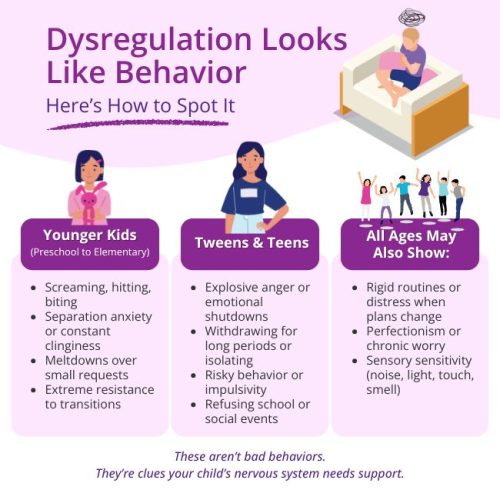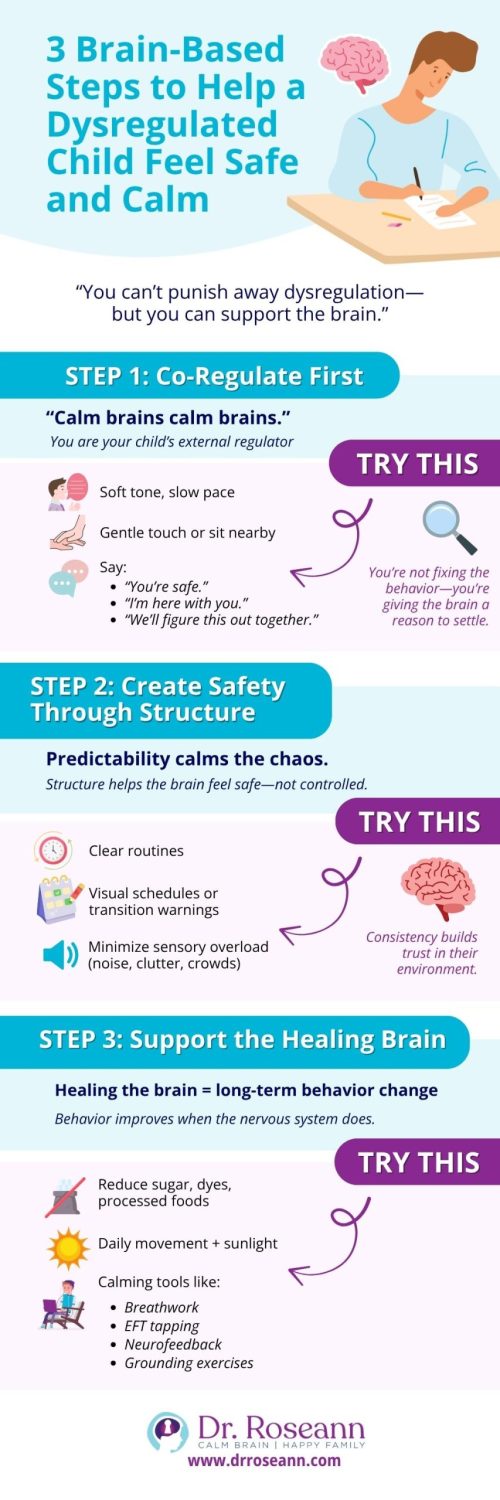Estimated reading time: 7 minutes
If your child goes from calm to chaos over the smallest things, I totally understand how it can leave you feeling confused, helpless, and unsure of what to do next.
These intense reactions are often signs of a dysregulated nervous system—and once we understand what’s really going on in the brain, we can start giving our kids the support they need to feel safe, grounded, and back in control.
What Is a Dysregulated Nervous System?
Your child’s nervous system is designed to act like a security system—always scanning for danger, always ready to protect. But when that system stays stuck on high alert, even ordinary moments can feel like an emergency.
That’s not “attitude”. That’s dysregulation – a brain in overdrive. Their brain is firing off false alarms all day long.
And no, it’s not your fault either.
You’re not failing as a parent. You’re raising a child whose nervous system just doesn’t feel safe right now.
And when we support and calm the nervous system, everything else starts to shift.
What Are the Behavioral Signs of a Dysregulated Nervous System in Children?
Every child is unique — but when their nervous system gets stuck in survival mode, certain patterns start to show up. The behaviors may shift depending on age, environment, or diagnosis (Paulus et al., 2021), but underneath it all, one thing is true: Your child doesn’t feel safe in their brain or body.

In Children (Preschool to Elementary):
- Screaming, hitting, biting, or kicking
- Separation anxiety or extreme clinginess
- Meltdowns over “no” or simple directions
You might wonder, “Are they just being strong-willed?”. Sometimes—sure. But more often, their brain is shouting, “I can’t handle this right now!”
In Teens
- Explosive outbursts followed by withdrawal
- Risk-taking or shutting down emotionally
- School refusal, social isolation, or avoidance
They may lash out or completely shut off. Both are signaling distress—not disrespect.
Across Ages, You Might Also See:
- Rigid routines or meltdowns when plans change
- Excessive worry or perfectionism because uncertainty feels unsafe
- Big reactions to noise, smells, textures—even someone’s tone of voice
These aren’t just growing pains. They’re red flags that your child needs nervous system support.
So if you’re seeing these patterns, it’s not just “a phase.” It’s your child’s nervous system waving a red flag—and asking for support.
What to Do When Your Child Is Dysregulated?
When your child is spiraling—whether they’re flipping furniture or hiding under the covers—your first job isn’t discipline. It’s regulation.
Because a dysregulated brain can’t reason, listen, or learn. And no healing ever happens in a nervous system that feels unsafe.

Step 1: Co-Regulate First
“Calm brains calm brains.” That’s not just a saying—it’s neuroscience.
Your nervous system sets the tone. When you stay grounded, you become the external regulator your child desperately needs in that moment (Paley & Hajall, 2022).
Try this:
- Keep your tone soft and your pace slow
- Offer a gentle touch or just sit close (if they’re open to it)
- Use soothing phrases like:
- “You’re safe.”
- “I’m here with you.”
- “We’ll figure this out together.”
You’re not fixing the behavior—you’re giving their brain a reason to settle.
Step 2: Create Safety Through Structure
Dysregulated kids aren’t looking for control—they’re craving predictability. When life feels uncertain, structure sends the message: You’re safe. Things are okay.
Help their brain feel anchored with:
- Clear, repeatable routines
- Visual schedules or transition warnings
- A calm environment (less noise, less clutter, fewer surprises)
You don’t need to be rigid—just consistent enough to calm their inner chaos.
Step 3: Support the Healing Brain
This is the piece most people miss: behavior doesn’t improve until the brain does. So instead of jumping to consequences, we focus on nervous system healing—because that’s what actually moves the needle.
Try brain-calming habits like:
- Cutting back on sugar, artificial dyes, and processed food
- Daily movement, sunlight, and unstructured play
- Tools that regulate from the inside out:
- Breathwork
- EFT tapping
- Neurofeedback
- Stretching or grounding exercises
Regulation is a learned skill—and your child can learn it. But first, we create the safety their brain has been missing.
Because as I always say: “Calm the brain first, everything follows.”
When Do Behavioral Signs of Dysregulation Warrant Concern?
When your child’s behavior feels bigger than the moment—meltdowns that come out of nowhere, extreme reactions to small changes, or emotional shutdowns that last for hours – it’s natural to wonder if something deeper is going on.
Recent research, including a 2025 review by Blader and colleagues (Evans and Althoff, 2025), shows that many behavioral outbursts in children and teens are actually signs of nervous system dysregulation—not intentional misbehavior.
Ask yourself:
- Are the outbursts or shutdowns happening most days?
- Is school, friendship, or daily life starting to feel too hard?
- Does your child seem constantly anxious, defiant, or emotionally checked out?
- Are even simple routines turning into daily battles?
- Do you feel like you’re walking on eggshells?
If any of this feels familiar, your child’s nervous system may be waving a red flag. Not because they’re being difficult—because they don’t feel safe.
Behavior is communication. When it interferes with connection or learning, it’s time to support the brain.
The good news? Regulation is a skill—and with the right support, your child can absolutely learn it.
You’re not alone. And there is a way forward.
Parent Action Steps
FAQs
How can I tell if my child’s behavior is due to dysregulation and not just “bad behavior”?
Look for patterns—frequent meltdowns, shutdowns, or overreactions that don’t respond well to typical discipline. Dysregulated behavior is often the nervous system’s way of saying, “I don’t feel safe.”
What are some quick ways to help my child regulate in the moment?
Use co-regulation: stay calm, speak slowly, and offer grounding phrases like “You’re safe” or “I’m here with you.” Help them feel safe first—logic can wait.
What’s the first step I should take as a parent?
Start by calming your own nervous system so you can co-regulate with your child. Then build structure, reduce sensory stress, and support the brain through food, movement, and calming tools.
Citations
Evans, S., and Althoff, R. (2025). On the regulation of emotions in child psychopathology commentary on Blader et al. J Child Psychol Psychiatry 66(4):595-598. https://doi.org/ 10.1111/jcpp.14141
Paley, B., & Hajal, N. J. (2022). Conceptualizing Emotion Regulation and Coregulation as Family-Level Phenomena. Clinical child and family psychology review, 25(1), 19–43. https://doi.org/10.1007/s10567-022-00378-4
Paulus, F. W., Ohmann, S., Möhler, E., Plener, P., & Popow, C. (2021). Emotional Dysregulation in Children and Adolescents With Psychiatric Disorders. A Narrative Review. Frontiers in psychiatry, 12, 628252. https://doi.org/10.3389/fpsyt.2021.628252
Dr. Roseann is a mental health expert in Self-Regulation who frequently is in the media:
- Healthline Understanding Self-Regulation Skills
- Scary Mommy What Is Self-Regulation In Children, And How Can You Help Improve It?
- HomeschoolOT Therapy Services Understanding Nervous System Dysregulation in Children: A Guide for Homeschool Parents
Always remember… “Calm Brain, Happy Family™”
Disclaimer: This article is not intended to give health advice and it is recommended to consult with a physician before beginning any new wellness regime. *The effectiveness of diagnosis and treatment vary by patient and condition. Dr. Roseann Capanna-Hodge, LLC does not guarantee certain results.
Are you looking for SOLUTIONS for your struggling child or teen?
Dr. Roseann and her team are all about science-backed solutions, so you are in the right place!
Grab your complimentary copy of









